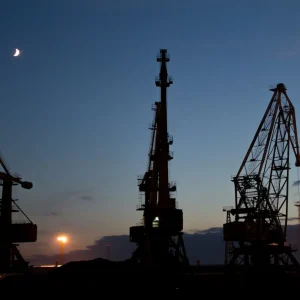
Inflation is a key economic factor that affects various industries, including the crane builders, hoist, and industrial lifting equipment sectors. In North America, these industries are critical to infrastructure development, manufacturing, and logistics. This article explores how inflation impacts these industries, considering cost structures, supply chains, pricing strategies, and future outlooks.
Understanding Inflation and Its Mechanisms
Inflation refers to the general increase in prices and the decline in the purchasing power of money over time. It can result from various factors, such as increased demand for goods and services, rising production costs, or expansionary fiscal policies. In North America, recent inflationary pressures have been attributed to supply chain disruptions, increased commodity prices, and significant fiscal stimulus measures.
Cost Structures in the Crane Builders and Hoist Industry
The crane builders, hoist, and industrial lifting equipment industries are highly sensitive to changes in input costs. Key components like steel, aluminium, electronics, and hydraulic systems are essential in manufacturing these products.
Raw Material Costs:
Steel and Aluminium: These metals constitute a significant portion of the material costs for cranes and hoists. Inflationary pressures have driven up prices for these commodities due to increased demand and supply chain disruptions. For instance, steel prices surged by over 50% in the past year, directly impacting the manufacturing costs for crane builders.
Electronics and Components: The global shortage of semiconductors and other electronic components has exacerbated costs and production delays. This shortage has particularly affected advanced lifting equipment, which relies heavily on electronic control systems and automation.
Labour Costs:
Skilled Labour Shortages: The crane and hoist industry requires skilled labour for design, engineering, and assembly. Inflation can lead to wage increases as workers seek higher compensation to keep up with the rising cost of living. This, in turn, raises overall production costs.
Supply Chain Disruptions
Supply chain disruptions have been a significant challenge for the crane builders and industrial lifting equipment industries, particularly in the wake of the COVID-19 pandemic. Inflation exacerbates these disruptions by increasing the costs of transportation, logistics, and raw materials.
Global Shipping Costs:
The cost of shipping containers has skyrocketed, partly due to inflation. This has led to increased costs for importing raw materials and components, further straining the supply chain. For example, the cost of shipping a container from Asia to North America has increased by over 200% in the past two years.
Domestic Transportation Costs:
Rising fuel prices have directly impacted domestic transportation costs. Trucking and rail services, essential for moving heavy equipment, have seen cost increases, which are then passed on to manufacturers and consumers.
Pricing Strategies and Market Adaptations
To mitigate the impact of inflation, companies in the crane and hoist industry have had to adapt their pricing strategies and operations.
Price Increases
Many manufacturers have responded to rising costs by increasing the prices of their products. This strategy helps maintain profit margins but can also reduce demand if customers are unwilling or unable to pay higher prices.
Cost Optimisation
Companies are looking to optimise their operations to reduce costs. This includes investing in more efficient production technologies, renegotiating supplier contracts, and improving inventory management to avoid stockouts and overproduction.
Diversification of Suppliers
To reduce dependency on a single source of materials, companies are diversifying their supplier base. This strategy helps mitigate the risk of supply chain disruptions and can provide some protection against price volatility.
Impact on Demand and Investment
Inflation can have a mixed impact on demand and investment in the crane builders and industrial lifting equipment sectors.
Reduced Capital Expenditure:
Higher costs can lead to reduced capital expenditure by companies that use cranes and hoists. This is particularly true for industries heavily impacted by inflation, such as construction and manufacturing. When costs rise, companies may delay or scale back investment in new equipment.
Shift in Demand Patterns:
There may be a shift in demand towards more cost-effective or versatile lifting solutions. For example, companies might prefer renting equipment over purchasing it to avoid the high upfront costs associated with new equipment.
Increased Focus on Maintenance and Upgrades:
Instead of investing in new equipment, companies may focus on maintaining and upgrading their existing machinery. This can extend the lifespan of their assets and delay the need for costly replacements.
Future Outlook
The future outlook for the crane builders, hoist, and industrial lifting equipment industry in North America will depend on several factors, including inflation trends, economic policies, and technological advancements.
Technological Innovations:
Technological advancements in automation, materials science, and renewable energy could offset some of the cost pressures associated with inflation. For example, the development of lighter and stronger materials could reduce raw material costs, while automation could improve manufacturing efficiency.
Policy Interventions:
Government policies aimed at controlling inflation, such as interest rate adjustments and fiscal measures, will play a crucial role. Additionally, infrastructure investment programmes, such as those proposed by the US government, could provide a boost to the demand for cranes and industrial lifting equipment.
Global Economic Conditions:
The global economic environment will also impact the industry. Factors such as trade policies, geopolitical tensions, and international demand for commodities will influence inflationary pressures and supply chain dynamics.
Conclusion
Inflation presents both challenges and opportunities for the crane builders, hoist, and industrial lifting equipment industry in North America. While rising costs and supply chain disruptions pose significant hurdles, companies can adapt through strategic pricing, cost optimisation, and technological innovation. The future of the industry will depend on how effectively these measures are implemented and how global economic conditions evolve. As inflationary pressures persist, staying agile and responsive to market changes will be crucial for maintaining competitiveness and growth in this vital sector.






